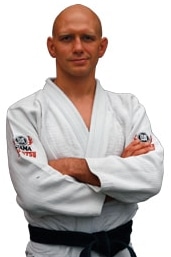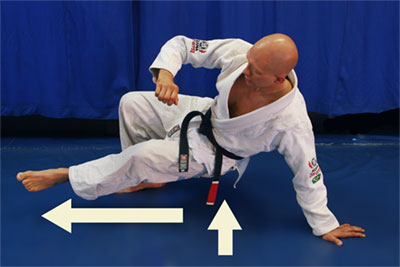
Why getting off the ground is a critical skills in grappling!
(originally published in Black Belt Magazine)
When mixed martial arts competition exploded in North America, martial artists quickly learned that most fights end up on the ground. And for years the prevailing wisdom was that groundfighting was inevitable, and if a fight went to the ground it would most likely stay there.
In the early 2000’s however MMA underwent a significant evolution. Fighters like Chuck Liddell, Wanderlei Silva and Denis Kang started regularly standing up out of the guard. Once they get to their feet they have the choice of striking their opponents or taking them down and ending up on top themselves.
I have sparred with several professional MMA fighters who were very difficult to keep down on the ground. Whenever I trained with my friend Denis Kang, for example, he was always mixing ‘normal’ guard attacks like sweeps and submissions with standup attempts. This made it difficult to know what he was going to do next.
He’d start with an armbar attempt and when I defended that by posturing up he’d use the newly created distance to scoot back to his feet.
Or he’d start by trying to stand up and when I drove into him to keep him pinned he’d use that energy to attack with an omoplata, Kimura, or another submission.
(And I should point out that a fight which rapidly switches between standing and the ground can be VERY tiring for someone who hasn’t specifically trained for that sort of action.)
So while many fights still go to the ground, the recent generation of mixed martial arts fighters have proved that fights don’t have to stay there.
There are two keys to developing the techniques shown in this article. The first is knowledge of the technique itself. You need to know what the correct steps are, where your hands and feet go, how to move your body, and so on.
The second key is to practice against a resisting opponent. Grab a partner, put him on top of you and tell him not to let you stand up. When you can regularly get back to your feet despite his best efforts to hold you down then you are well on your way to having mastered standup techniques.
Most martial artists work long and hard to develop their striking techniques. If striking is your thing, that’s great! Just make sure you know how to get back to your feet should you get taken down to the ground, so that you can actually use all those great striking techniques in your repertoire!
Technique 1 – The Solo Standup
This standup is the foundation of most standup techniques, and it is the place to start if all this material is new to you. The best part is that you can practice this movement on your own.
When you use this technique in real life you’re going to do it quickly. In training, however, make sure that you practice the movement both quickly and slowly. Doing it slow ensures that your hands and feet are in the right place, and that you’re not simply relying on momentum to get you up.
One of the keys of this technique is to pendulum your body backwards as your weight is supported entirely by one hand and one foot. Dragging any part of your body on the ground as you move forwards and backwards will slow you down and increase your vulnerability here.
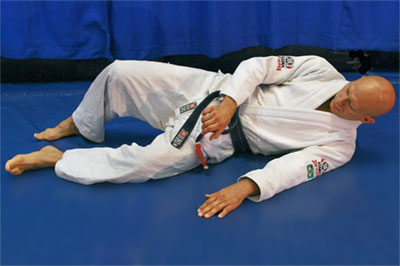
Stephan starts in a side breakfall position.
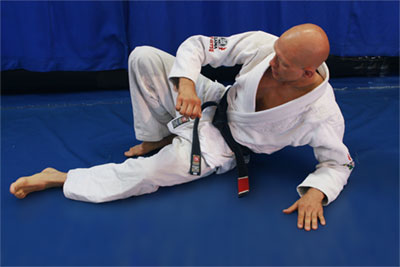
He comes up onto his elbow, keeping his other arm up to protect the face.
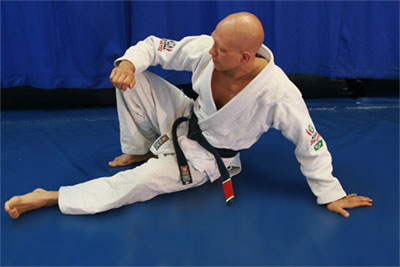
He now sits all the way up, posting his hand behind him.

Stephan lifts his hips off the ground and kicks forward with his bottom leg.
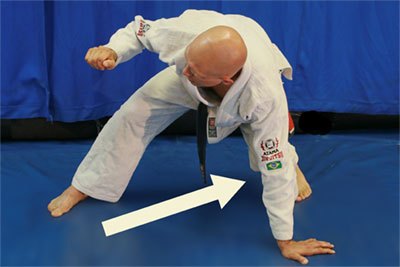
He then brings his kicking leg back between his hand and his foot.
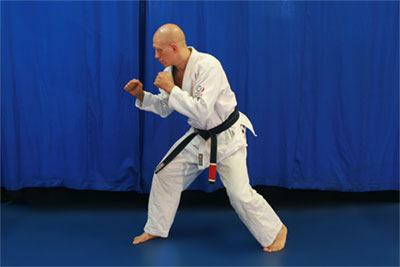
And comes up to a balanced fighting stance.
Technique 2 – Basic standup versus an opponent
In this technique your opponent is standing over you. You are keeping him at bay by lying on your back and bicycle kicking his legs and body, but you can’t stand up because that would give him a great opportunity to punch or kick you.
What can you do?
The answer is that you need to do three things simultaneously: you need to stand up, AND you need to keep at least one hand up protecting you, AND you need move backwards to create enough room to be safe from your opponent’s strikes. You need to do these three things all at the same time.
This technique is an application of the solo standup drill shown earlier.
 Stephan has been knocked down… |
|
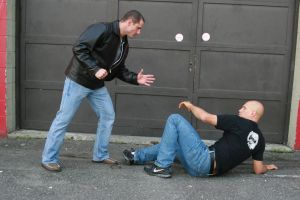 Keeping his eyes on his attacker he comes up onto one elbow |
|
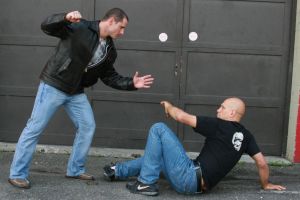 Now he comes up onto his hand, shielding his face with the other arm |
|
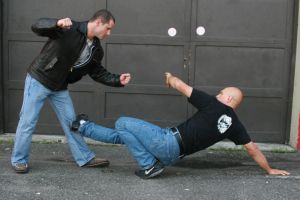 He lifts his hips and shifts forward, kicking the knee to make space |
|
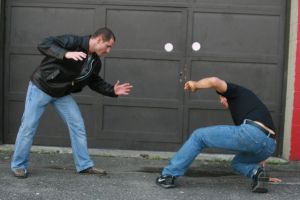 Stephan retracts the kicking leg underneath his body… |
|
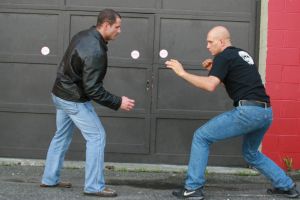 And comes up to a fighting stance |
. |
Technique 3: Butterfly Guard Standup
It’s important to practice the same technique from different starting positions, because you never know exactly how things are going to turn out. In this technique you start out in the ‘butterfly guard’, which is a style of guard where you are sitting up with your insteps positioned inside your opponent’s thighs.
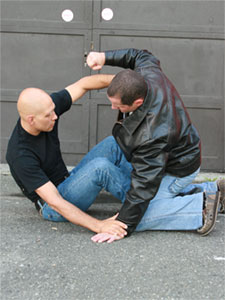 Stephan is using the butterfly guard to defend against strikes. |
|
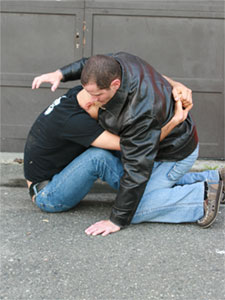 He ducks his head against the chest and secures a bodylock with both arms . |
|
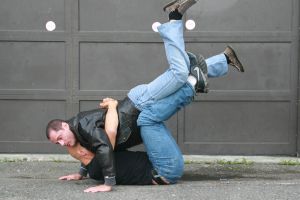 Stephan hops his hips forward and elevates his opponent using both legs. |
|
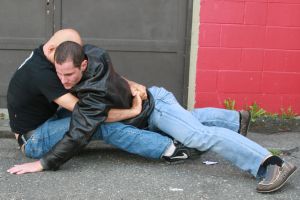 He drops his opponent and kicks him away, stretching him out. |
|
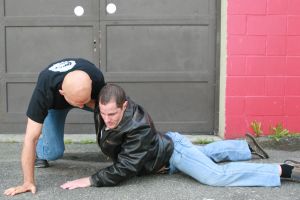 Stephan uses the space he’s created to bring one leg out and behind him. |
|
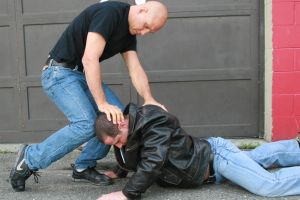 He can now run away or finish the fight with a knee strike. |
Technique 4: Hip Bump Standup from Closed Guard
Here you are starting in the closed guard, with your ankles crossed behind your opponent’s back. This is a good position from which to attack and defend, but standing up is a little tricky because it’s easy for your opponent to drop his weight down on top of you.
In order to get back to the feet from this position you are going to use a hip bump to create some room. Then, before he can settle his weight back down on you, you escape a leg backwards and stand up. This is a very powerful technique, proven in MMA competition, but it requires close attention to detail and repetition to be effective.
 From inside the closed guard, Jason throws punches at Stephan. |
|
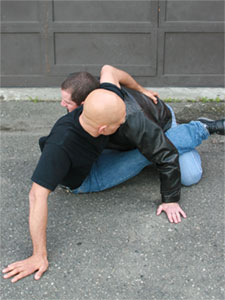 Stephan defends by sitting up, reaching over the shoulder and scooting his hips to the left. |
|
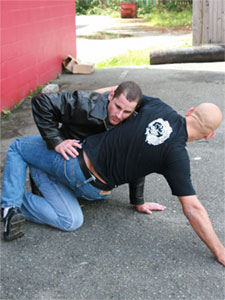 He now lifts his hips, bumping his opponent to the right. |
|
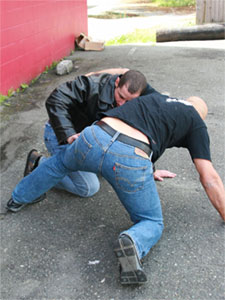 The bump creates enough room for Stephan to retract his right leg. Note how BOTH his legs are now out from under his opponent’s body! |
|
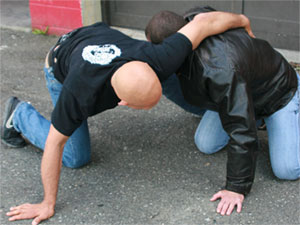 A different angle of the same movement |
|
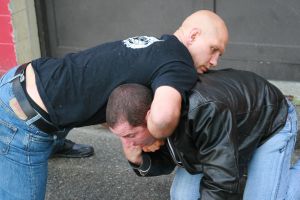 Stephan can now attack with a front headlock… |
|
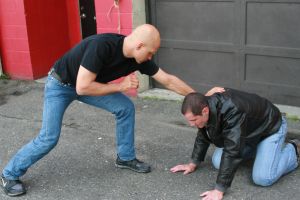 …or step back and disengage from the ground. |
FOR MORE INFORMATION: Check out the standup techniques, drills, followups and combinations that are covered in detail by MMA fighter Denis Kang in the My Mixed Martial Arts DVD available at Grapplearts.com.
This DVD contains tons of great techniques and training drills that are as relevant to street self-defense as they are to MMA training and competition! It’s one of my favorite DVDs!
Stephan Kesting
Grapplearts.com

